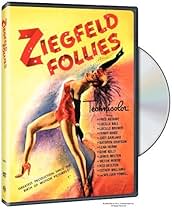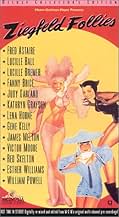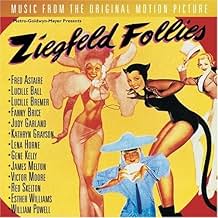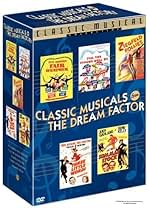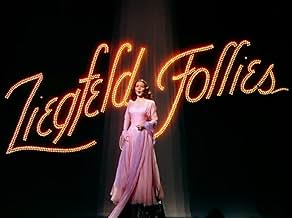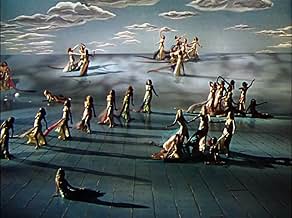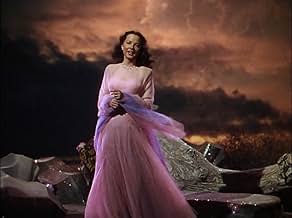IMDb-BEWERTUNG
6,4/10
3874
IHRE BEWERTUNG
Füge eine Handlung in deiner Sprache hinzuThe late, great impresario Florenz Ziegfeld Jr. looks down from Heaven and ordains a new revue in his grand old style.The late, great impresario Florenz Ziegfeld Jr. looks down from Heaven and ordains a new revue in his grand old style.The late, great impresario Florenz Ziegfeld Jr. looks down from Heaven and ordains a new revue in his grand old style.
- Auszeichnungen
- 1 Gewinn & 1 Nominierung insgesamt
Empfohlene Bewertungen
If you get easily bored with those old movies that seem to roll and roll forever, this is for you. It really has no plot, but you really don't need one. You could call this movie the Grand Ball, because it really is a set of dances. (Except for a few comedy scenes) Overall, I strongly believe that it is a really good movie, especially in those Fred Astaire numbers (Here's to the Girls, This Heart of Mine, and the Limehouse Blues) This movie is a real MUST for classic movie and Ziegfeld lovers alike.
This film is just what it says on the tin, a collection of pieces and sketches similar to those you would have seen in a real Ziegfeld show.
Introduced from Heaven by Ziegfeld himself (William Powell reprising his role of ten years earlier), the acts are rolled out one by one for our appreciation and enjoyment.
High points which spring to mind are Fred Astaire as a jewel thief, charming Lucille Bremer; and as a Chinese n'er do well wishing he could get Bremer the fan she wants. Cyd Charisse and others dancing through bubbles as Kathryn Grayson warbles 'Beauty'. Judy Garland as 'the great lady' mocking Greer Garson. And of course 'The Babbitt and the Bromide' which teams Astaire and Gene Kelly for the first time.
The comedy segments sit less well today and all are too long, however, they're not bad. Keenan Wynn struggles with a dumb telephone operator; Victor Moore has a tightwad lawyer who gets him into jail; Fanny Brice wins the Irish sweepstake; and Red Skelton advertises Guzzler's Gin.
Add Lucille Ball and her cat girls, a touch of La Traviata, and a bevy of lovelies to open and close the show, and you can see why this film was a hit on its first release.
Good for historical interest and the frequent highs, but you might find your attention wandering now and then.
Introduced from Heaven by Ziegfeld himself (William Powell reprising his role of ten years earlier), the acts are rolled out one by one for our appreciation and enjoyment.
High points which spring to mind are Fred Astaire as a jewel thief, charming Lucille Bremer; and as a Chinese n'er do well wishing he could get Bremer the fan she wants. Cyd Charisse and others dancing through bubbles as Kathryn Grayson warbles 'Beauty'. Judy Garland as 'the great lady' mocking Greer Garson. And of course 'The Babbitt and the Bromide' which teams Astaire and Gene Kelly for the first time.
The comedy segments sit less well today and all are too long, however, they're not bad. Keenan Wynn struggles with a dumb telephone operator; Victor Moore has a tightwad lawyer who gets him into jail; Fanny Brice wins the Irish sweepstake; and Red Skelton advertises Guzzler's Gin.
Add Lucille Ball and her cat girls, a touch of La Traviata, and a bevy of lovelies to open and close the show, and you can see why this film was a hit on its first release.
Good for historical interest and the frequent highs, but you might find your attention wandering now and then.
If a star-studded Hollywood cast from the 'Golden' years makes you enjoy a film, that alone will be enough to tide you over the nearly 2 hours of this musical bonanza. It seems nearly everyone is present.
True to the nature of the revue, there's no story and just a series of vignettes that come and go. Among them, Fred Astaire and Gene Kelly have a dance show-off, your only chance to see one from this time. Esther Williams gives us a lovely underwater ballet, I would like to see more of her.
In spite of the scale of the production, the lavish sets and elaborate costumes, this is not, of course, aristocratic entertainment for those with a refined taste in music and dance but low brow frill aimed at the broad audience.
The revue was television of its time - an opportunity to shift among a few fluffy entertainments after a long day, nothing demanding our engagement beyond the few minutes of a skit. These days it seems to survive in SNL. The bits here alternate between broad comedy skits and song and dance numbers.
It's not bad, not particularly great either. It's not what I look for in a musical, and I will always opt for the fuller engagement of long narrative.
More interesting for me here are all the self-referential bits.
In the Astaire/Kelly show-off Fred, established musical royalty, plays a joke of pretending to not know who Kelly is.
Judy Garland enters her segment as herself, musing to a chorus of reporters about preferring song and dance roles rather than dramatic.
These people are here as themselves, the veneer of fiction is thin, opportunity for scenery and costume. You'll see some gorgeous examples of both, among the standouts for me being the all red ballroom in which Astaire swindles the rich countess and the dreamy finale, with chorus girls swirling through billows of bubbly foam. Briefly glimpsed among them is Cyd Charissee in her first appearance.
The whole is framed as Ziegfeld in heaven reminiscing about the shows he put on.
My favorite bit is the Chinatown skit with Astaire as a poor coolie dreaming about a woman he passes by on the street. His unrequited love becomes a dance they have together holding hand fans.
True to the nature of the revue, there's no story and just a series of vignettes that come and go. Among them, Fred Astaire and Gene Kelly have a dance show-off, your only chance to see one from this time. Esther Williams gives us a lovely underwater ballet, I would like to see more of her.
In spite of the scale of the production, the lavish sets and elaborate costumes, this is not, of course, aristocratic entertainment for those with a refined taste in music and dance but low brow frill aimed at the broad audience.
The revue was television of its time - an opportunity to shift among a few fluffy entertainments after a long day, nothing demanding our engagement beyond the few minutes of a skit. These days it seems to survive in SNL. The bits here alternate between broad comedy skits and song and dance numbers.
It's not bad, not particularly great either. It's not what I look for in a musical, and I will always opt for the fuller engagement of long narrative.
More interesting for me here are all the self-referential bits.
In the Astaire/Kelly show-off Fred, established musical royalty, plays a joke of pretending to not know who Kelly is.
Judy Garland enters her segment as herself, musing to a chorus of reporters about preferring song and dance roles rather than dramatic.
These people are here as themselves, the veneer of fiction is thin, opportunity for scenery and costume. You'll see some gorgeous examples of both, among the standouts for me being the all red ballroom in which Astaire swindles the rich countess and the dreamy finale, with chorus girls swirling through billows of bubbly foam. Briefly glimpsed among them is Cyd Charissee in her first appearance.
The whole is framed as Ziegfeld in heaven reminiscing about the shows he put on.
My favorite bit is the Chinatown skit with Astaire as a poor coolie dreaming about a woman he passes by on the street. His unrequited love becomes a dance they have together holding hand fans.
If you're watching ZIEGFELD FOLLIES expecting a plot of any kind, or even an attempt at one, you'd probably be quite horrifically let down by this film. It's best to approach and accept it for what it is--a crazy filmic patchwork of song and dance and sketches, with some that undoubtedly work better than others, and some that are best left forgotten in the annals of film history. If you *do* bear this in mind, ZIEGFELD FOLLIES is an amusing way to spend a couple of hours as you watch these famous stars, including Fred Astaire, Lucille Ball, Gene Kelly, Judy Garland and many many more trying their utmost best to entertain you. (Admittedly, some with better success than others!)
The film opens with William Powell as Florenz Ziegfeld (reprising his role in THE GREAT ZIEGFELD for what really amounts to a cameo), looking down from heaven as he plans to put up one last, great Ziegfeld follies using the best stars of the day. What immediately follows is the trademark very very pink number, with girls galore floating by on merry-go-round horses, that segues into a rather surreal bit with Lucille Ball (properly attired in a pink fluffy concoction) brandishing a whip (oh dear) against several girls in very sexily-cut black leather body suits. It's an... interesting way to kick the film off, let's leave it at that.
There's no real way to summarise ZIEGFELD FOLLIES except by singling out one's own favourite numbers. And in the forest of boring (Keenan Wynn wastes his talents in a grating and predictable phone sketch), over-the-top (feast your eyes on Esther Williams' water ballet or Kathryn Grayson's operatic warbling as Cyd Charisse dances through bubble mountains) and just plain weird (Judy Garland performing what could well be the first rap in Classic Hollywood--it's not an altogether pretty picture), all of Astaire's contributions to the film stand out.
Astaire is the ostensible star of the film, appearing no less than four times with three gorgeous dance sequences that could certainly count among his personal best. In two of them he's partnered with Lucille Bremer to pleasing effect. "This Heart Of Mine" features Astaire in his rogue persona as he romances Bremer with dance (doesn't he always?) only to steal her jewelry... and for her to steal his heart. The better of their collaborations is the odd but intriguing "Limehouse Blues" with the two of them made up like Chinese (Astaire almost--*almost*--carries it off but ends up looking a little silly). Leaving aside stereotypes, the ballet in Tai Long's fevered dreams is quite stunning, and impeccably staged. I'm still trying to figure out how Astaire and Bremer managed to remember the exact way in which to flip their fans... I hate to think how many times they must have reshot that just to get it all perfectly synchronised!
My favourite number in ZIEGFELD FOLLIES, small surprise, is the one I was looking out for: the penultimate number, "The Babbitt & The Bromide", featuring Astaire and Kelly together on screen, performing the same routine for once in their long illustrious careers. It's a funny little number, with the two fellows they play meeting each other at every stage of their lives, only to have the same inane, mundane conversation. Then follows a small bout of onemanupship as they try to out-dance the other, right into the gates of Heaven. Watching them together is a real treat, because you know these are probably the two best dancer/singer/actors ever committed to film. It's a bit of a shame that their styles don't quite gel: Astaire floats his way through the routine as Kelly pounds the ground as only he can, so their dancing is polished, in perfect time (the timing is absolutely amazing!), but just a little bit off-kilter. It's still the best number in ZIEGFELD FOLLIES though, with Kelly's irrepressible mischief playing against Astaire's ruffled charm.
ZIEGFELD FOLLIES is really just a big, sparkly candy box of a movie--if you bear in mind that a plot was never particularly high on the mind of writers, producers, or directors, and you have a good book by your side to tide you through the (fortunately not too numerous) stretches of boredom, you're set for the evening. Keep the video ready for whenever Astaire breaks onto the screen; that's always a sign of quality. 7/10
The film opens with William Powell as Florenz Ziegfeld (reprising his role in THE GREAT ZIEGFELD for what really amounts to a cameo), looking down from heaven as he plans to put up one last, great Ziegfeld follies using the best stars of the day. What immediately follows is the trademark very very pink number, with girls galore floating by on merry-go-round horses, that segues into a rather surreal bit with Lucille Ball (properly attired in a pink fluffy concoction) brandishing a whip (oh dear) against several girls in very sexily-cut black leather body suits. It's an... interesting way to kick the film off, let's leave it at that.
There's no real way to summarise ZIEGFELD FOLLIES except by singling out one's own favourite numbers. And in the forest of boring (Keenan Wynn wastes his talents in a grating and predictable phone sketch), over-the-top (feast your eyes on Esther Williams' water ballet or Kathryn Grayson's operatic warbling as Cyd Charisse dances through bubble mountains) and just plain weird (Judy Garland performing what could well be the first rap in Classic Hollywood--it's not an altogether pretty picture), all of Astaire's contributions to the film stand out.
Astaire is the ostensible star of the film, appearing no less than four times with three gorgeous dance sequences that could certainly count among his personal best. In two of them he's partnered with Lucille Bremer to pleasing effect. "This Heart Of Mine" features Astaire in his rogue persona as he romances Bremer with dance (doesn't he always?) only to steal her jewelry... and for her to steal his heart. The better of their collaborations is the odd but intriguing "Limehouse Blues" with the two of them made up like Chinese (Astaire almost--*almost*--carries it off but ends up looking a little silly). Leaving aside stereotypes, the ballet in Tai Long's fevered dreams is quite stunning, and impeccably staged. I'm still trying to figure out how Astaire and Bremer managed to remember the exact way in which to flip their fans... I hate to think how many times they must have reshot that just to get it all perfectly synchronised!
My favourite number in ZIEGFELD FOLLIES, small surprise, is the one I was looking out for: the penultimate number, "The Babbitt & The Bromide", featuring Astaire and Kelly together on screen, performing the same routine for once in their long illustrious careers. It's a funny little number, with the two fellows they play meeting each other at every stage of their lives, only to have the same inane, mundane conversation. Then follows a small bout of onemanupship as they try to out-dance the other, right into the gates of Heaven. Watching them together is a real treat, because you know these are probably the two best dancer/singer/actors ever committed to film. It's a bit of a shame that their styles don't quite gel: Astaire floats his way through the routine as Kelly pounds the ground as only he can, so their dancing is polished, in perfect time (the timing is absolutely amazing!), but just a little bit off-kilter. It's still the best number in ZIEGFELD FOLLIES though, with Kelly's irrepressible mischief playing against Astaire's ruffled charm.
ZIEGFELD FOLLIES is really just a big, sparkly candy box of a movie--if you bear in mind that a plot was never particularly high on the mind of writers, producers, or directors, and you have a good book by your side to tide you through the (fortunately not too numerous) stretches of boredom, you're set for the evening. Keep the video ready for whenever Astaire breaks onto the screen; that's always a sign of quality. 7/10
Ziegfeld Follies is a musical comedy from 1946, from the time when they made lots of musical movies.There really isn't a plot in this movie, but who needs one anyway.As long the musical numbers are working, you really don't need a plot in a movie like this.And then there are also some really funny sketches in the movie.Especially I liked Red Skelton's and Keenan Wynn's acts.They really make you laugh.And then it is great fun to watch Fred Astaire's and Gene Kelly's musical number.This was their only musical act together.Ziegfeld Follies has many great musical numbers.The younger generation doesn't care so much about musical movies, but I'm a teen ager and I like these old musical movies.These kind of movies make me miss those times, and I wasn't even born back then!
Wusstest du schon
- WissenswertesAt the beginning of the "Bring On The Beautiful Girls" number, several older women are shown; these are women who actually appeared in the original Ziegfeld Follies on stage.
- PatzerTowards the end of "This Heart of Mine", as Fred Astaire and Lucille Bremer begin to dance back to the palace, dancers in the background (screen left) struggle to stabilize some of the antler-tree props.
- Zitate
Florenz Ziegfeld Jr.: Children play with the dreams of tomorrow. And old men play with the memories of yesterday.
- Crazy CreditsZiegfeld Follies credits are in alphabetical order. That is why "Bunin" comes before "Charisse"
- Alternative VersionenThere is an Italian edition of this film on DVD, "FOLLIE DI ZIEGFELD", re-edited in double version (1.33:1 and 1.78:1) with the contribution of film historian Riccardo Cusin This version is also available for streaming on some platforms.
- VerbindungenEdited into Hollywood: The Dream Factory (1972)
- SoundtracksHere's to the Girls
Music by Roger Edens
Lyrics by Arthur Freed
Sung by Fred Astaire, chorus
Danced by Cyd Charisse, Lucille Ball, chorus
Top-Auswahl
Melde dich zum Bewerten an und greife auf die Watchlist für personalisierte Empfehlungen zu.
- How long is Ziegfeld Follies?Powered by Alexa
Details
- Erscheinungsdatum
- Herkunftsland
- Sprache
- Auch bekannt als
- Ziegfeld Follies of 1944
- Drehorte
- Produktionsfirma
- Weitere beteiligte Unternehmen bei IMDbPro anzeigen
Box Office
- Budget
- 3.240.816 $ (geschätzt)
- Laufzeit1 Stunde 25 Minuten
- Farbe
- Seitenverhältnis
- 1.37 : 1
Zu dieser Seite beitragen
Bearbeitung vorschlagen oder fehlenden Inhalt hinzufügen

Oberste Lücke
By what name was Broadway-Melodie 1950 (1945) officially released in India in English?
Antwort

